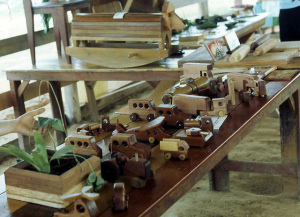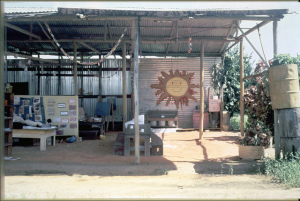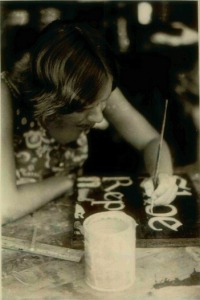The art created by the craftspeople of Jonestown reflected the progressive work-based concepts embraced by the agricultural commune from which it arose. While human experience and collaboration may have been themes of the art produced by those who lived in Jonestown, their pragmatic concept of art did not limit creativity. The experiential and cooperative nature of Jonestown’s art conveyed social meaning to its existence. A communal work-based concept of arts and crafts is compatible with a viewpoint in which art has social relevance, and so it manifested itself in Jonestown. The artistic works represented a constructive social response to a harsh environment, which resulted in a community-centered artistic concept differing from that of mainstream capitalist society.
 The Fate of Jonestown Art: We hear little about the art made in Jonestown, but it provided more than a window into the lives of those who lived there. It was a creative language through which the Jonestown community found expression of their experience. The repression of this art through the loss and destruction of artifacts after 1978 was part of the deculturalization of Jonestown and the silencing of its residents. Only a few photos of artifacts created in Jonestown survived the community’s death. The Temple organization itself also destroyed many photos, before and after 1978, suggesting an internal repression of individual and community voice within the organizational hierarchy. Internal repression of the freedoms of temple members, in addition to the already difficult external environment, may have driven creativity toward communal work-based expression.
The Fate of Jonestown Art: We hear little about the art made in Jonestown, but it provided more than a window into the lives of those who lived there. It was a creative language through which the Jonestown community found expression of their experience. The repression of this art through the loss and destruction of artifacts after 1978 was part of the deculturalization of Jonestown and the silencing of its residents. Only a few photos of artifacts created in Jonestown survived the community’s death. The Temple organization itself also destroyed many photos, before and after 1978, suggesting an internal repression of individual and community voice within the organizational hierarchy. Internal repression of the freedoms of temple members, in addition to the already difficult external environment, may have driven creativity toward communal work-based expression.
 Jonestown Art: The Peoples Temple Agricultural Project Progress Report-Summer 1977 gave testimony to the importance placed on the arts and crafts in the Jonestown School, which listed artistic development among the attributes relevant to the growth of the child in all aspects of life. The Jonestown School included the language arts, writing, music, arts, and crafts as part of the curriculum. Creative activities emphasized use of local and available materials. The school engaged the work-study concept at all levels of education. In addition, the brochure Jonestown: A Model of Cooperation published in early 1978 mentions the offering of evening classes in arts and crafts for all ages. On 19 June 1978, the Guyana Chronicle reported that the Jonestown Community School had achieved Official Status according to Guyanese government requirements. The article mentions woodworking, clothing manufacture, and home economics as being among the activities that involved people of all ages in the Jonestown community.
Jonestown Art: The Peoples Temple Agricultural Project Progress Report-Summer 1977 gave testimony to the importance placed on the arts and crafts in the Jonestown School, which listed artistic development among the attributes relevant to the growth of the child in all aspects of life. The Jonestown School included the language arts, writing, music, arts, and crafts as part of the curriculum. Creative activities emphasized use of local and available materials. The school engaged the work-study concept at all levels of education. In addition, the brochure Jonestown: A Model of Cooperation published in early 1978 mentions the offering of evening classes in arts and crafts for all ages. On 19 June 1978, the Guyana Chronicle reported that the Jonestown Community School had achieved Official Status according to Guyanese government requirements. The article mentions woodworking, clothing manufacture, and home economics as being among the activities that involved people of all ages in the Jonestown community.
 The artwork created in Jonestown tended to be a pragmatic expression of the cooperative work-based ideals of the agricultural commune. Photographs and literature provide evidence of the following arts and crafts: toy-making, sign-making, crafting of stuffed animals, jewelry design, clothing design, textile art, painting, drawing, woodworking, metallurgy, candle-making, and culinary arts. The many photographs that provide the memory of life at Jonestown should be included among the works of art. Video tapes, audio tapes, and written literature tell the stories of the images portrayed in the photographs. The brochures, diaries, letters, and poetry of Jonestown illustrate the ideals of a social movement and its members. Children’s art and poetry is notable for its honesty in portraying the life experience of children and adults. The children’s poems of Jonestown relate the stories of children removed from the pollution, crime, and violence of America’s cities to the pristine jungles of Guyana. Music and dance played a significant role in the Temple. Even before the migration to Guyana, the Temple choir produced the 1973 album He’s Able through its own label of Brotherhood Records, an album which demonstrates the connection between the music and the group’s ideology.
The artwork created in Jonestown tended to be a pragmatic expression of the cooperative work-based ideals of the agricultural commune. Photographs and literature provide evidence of the following arts and crafts: toy-making, sign-making, crafting of stuffed animals, jewelry design, clothing design, textile art, painting, drawing, woodworking, metallurgy, candle-making, and culinary arts. The many photographs that provide the memory of life at Jonestown should be included among the works of art. Video tapes, audio tapes, and written literature tell the stories of the images portrayed in the photographs. The brochures, diaries, letters, and poetry of Jonestown illustrate the ideals of a social movement and its members. Children’s art and poetry is notable for its honesty in portraying the life experience of children and adults. The children’s poems of Jonestown relate the stories of children removed from the pollution, crime, and violence of America’s cities to the pristine jungles of Guyana. Music and dance played a significant role in the Temple. Even before the migration to Guyana, the Temple choir produced the 1973 album He’s Able through its own label of Brotherhood Records, an album which demonstrates the connection between the music and the group’s ideology.
African American art is notable for its freedom of expression and openness toward new ideas. The art, literature, and music of Jonestown reflected this freedom, as in the poetry through which children communicated their life stories. It embraced an artistic concept that was divergent in its emphasis on social experience and usefulness. Jonestown art was an expression of the cooperative work involved in building a utopian community, and achieved meaning in its relevance to human experience.
The intent of this paper was to present a brief review of the art created by those who lived in Jonestown. It is hoped that this article will lead to more research on the art of Jonestown, both that made by those who experienced life inside of the Agricultural Project, and those who seek to honestly portray their creative impressions related to the Jonestown experience.
(Edward Cromarty is a frequent contributor to this website. His complete collection of articles is here. He can be reached at edwardcromarty@hotmail.com.)